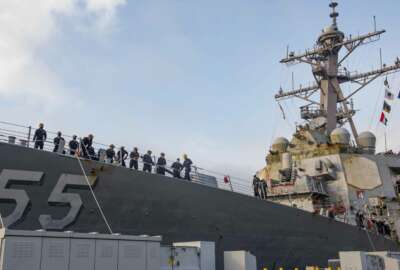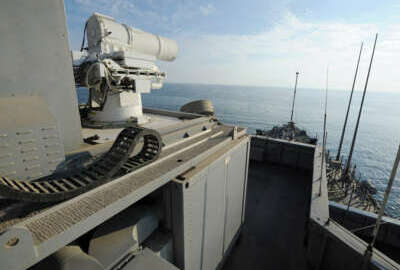What’s in a name? For the Department of the Navy, it signifies resolve
Aaron Weis, the Department of Navy’s chief information officer, detailed several programs to move away from old technology and bring the service into a modern...
You have to admit, when an initiative or program includes a creative name, there is something more alluring to the effort.
The Air Force with Kessel Run, the Space Force with Kobayashi Maru or the Defense Department’s JEDI — Joint Enterprise Defense Infrastructure — attracted a lot more attention than if they were called what they actually where: Faster software development, an operational platform and secure public cloud services.
The Navy may be taking this fun and clever effort one step further.
From Operation Cattle Drive to Operation Flank Speed to Super Nova, the Navy is adding the fun back to IT modernization.

“We have ideas. I think we had a previous undersecretary who was from Oklahoma so the idea of a cattle drive really appealed to him, and we just ran with it,” said Aaron Weis, the Department of the Navy’s chief information officer, after he spoke at the recent AFCEA Northern Virginia Navy IT day in Arlington, Virginia. “We have some great names like Black Pearl [a software delivery initiative] and I think the coolest name in DoD for any program is Kessel Run because I’m a ‘Star Wars’ nerd so I get it. It’s a measure of time not distance. It’s very cool.”
Creativity and fun naming conventions aside, the impact of these programs on the Department of Navy’s IT modernization efforts is becoming clear.
Weis, who has been the DoN CIO since October 2019, has chipped away at what he describes as an infrastructure that is 15-to-20 years behind industry.
“We are making great strides, but we have an infrastructure is much like our fleet that needs to be recapitalized and we need to modernize and reinvigorate it in a new way. We have infrastructure that, for the most part, is not supporting the mission. We have an environment that has not done an exemplary job of defending our information whether that is in our internal networks or in the networks in our partners in the industrial base. We have a lot to do, but we have accomplished a lot over the last couple of years.”
And each of those accomplishments is tied to one of those creative names.
Operation Flank Speed
This is the DoN’s move to Office 365 after the success of the Commercial Virtual Remote (CVR) initiative launched across all of the Defense Department during 2020 at the height of the pandemic.
Weis said they are driving the implementation with “vigor.”
“Across the Department of Navy, we are at about 400,000 seats deployed into a universe of about 650,000 seats. The Marines Corps have finished their roll out and are on to their next step. The Navy is making great strides and are about half way through with plan to be done in March,” he said. “That is a wholesale reimaging of how we enable sailors, marines and civilians to get their job done and do it from wherever they are. Little things that I took for granted when I was a CIO in industry like I can do all of that from my phone, I can access my documents from my phone and I can log in from anywhere from my remote desktop and be completely productive in a matter of minutes.”
Weis said this wasn’t the case two years ago as the Navy was living in a technology world that pre-dated 2008. Now, Weis said, the DoN is closer to 2017 and getting closer to 2021 every day.
“We also articulated a cloud vision and strategy and released an enterprise cloud strategy that talked about how we wanted to leverage the cloud and drive innovative solutions and do that at scale,” he said. “Importantly, we started down the path of a naval identity service. We are rolling out identity and access management across the Department of the Navy as an enterprise service that leverages the cloud. We didn’t start with a pilot. We connected the Navy enterprise resource planning (ERP), and that Navy ERP system has 75,000 users and all will be live imminently on the Navy’s identity service.”
The identity and access management enterprise service is part of a new effort across the DoN to give commands access to subscription based technology capabilities.
Weis said the memo detailing this enterprise services effort should be finalized in the coming weeks.
“Where it makes sense, we will put in place underlying capabilities that multiple organizations and systems could use,” he said. “It’s instructional for acquisition. The acquisition community are the ones that will largely benefit from this.”
Operation Cattle Drive
Weis called this a “mysterious program,” which is an acknowledgement that the Department of Navy is bad at turning off old systems and it needs to get rid of them.
“Operation Cattle Drive is an acknowledgement that we need to put all those cattle on a path to market. If you know anything about a cattle drive, the cattle don’t fare well at the end of a cattle drive,” he said. “We are doing that. We’ve already gone through the financial management portfolio. We’ve combined forces with the financial management community because the DoN CIO doesn’t have a lot of superpowers, but one that it does have is it can de-authorize any systems, take away its authority to operate (ATO). Once that happens, Fleet Cyber Command or Marine Forces Cyber Command will snip it off from the network. So combine that with our ability through the assistant secretary of the Navy (ASN) Financial Management and Comptroller (FM&C) to stop the flow of money, we can drive those cattle to market, and that is what we are doing.”
So far, the CIO and financial management community have identified more than $100 million annually of old systems that will go away.
“They wanted to be the first ones and try it themselves and it was a success,” Weis said. “We work with the stakeholders to understand where the opportunities are and work with acquisition and FM&C and help them drive to that end.”
Weis said next up is the logistics IT portfolio.
“We spend more than $1 billion a year to sustain the logistic IT portfolio and it’s full of cattle. We will go after that,” he said. “Along with our own world as we modernize this IT infrastructure, we have all kinds of boat anchors we want to cut off as we retire this legacy infrastructure.”
Weis said Super Nova—another creative name—is the program looking at the assortment of analytics tools and systems across the Department of the Navy.
“The number is rarely or ever one. But it’s something south of what we have today,” he said. “We really don’t need 300 logistics systems. We probably need a number less than that. Is it one? No. Is it 5, 6, 10 or 12? I don’t know. But that is the spirit of Operation Cattle Drive. We will do that for analytics systems under Super Nova.”
Copyright © 2024 Federal News Network. All rights reserved. This website is not intended for users located within the European Economic Area.
Jason Miller is executive editor of Federal News Network and directs news coverage on the people, policy and programs of the federal government.
Follow @jmillerWFED






